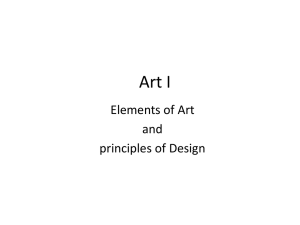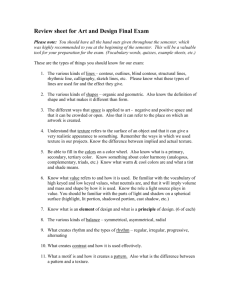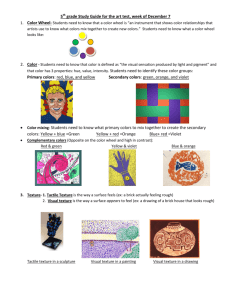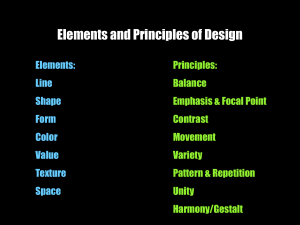Elements of Art
advertisement
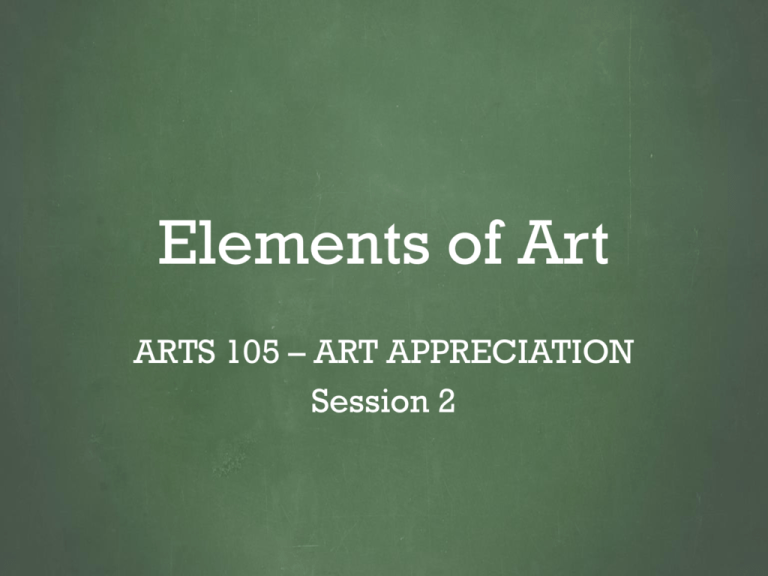
Elements of Art ARTS 105 – ART APPRECIATION Session 2 Elements of Art • The elements of art are the “elements” or formal tools that artists use to create a work of art. •Line •Shape •Value •Form •Space •Color •Texture LINE • Line is a tool that we use to define the edges of a 2-D Shape (flat) or a 3-D Form (in the round) • Line has a beginning and an end Egon Schiele, Portrait of Eduard Kosmack, Frontal, with Clasped Hands, 1910, Charcoal Contour Line -defines the edge of a shape or object Alice Neel Implied Line Alberto Giacometti, Falling Man, 1950, Bronze, 60 x 22 x 36 cm -shows direction and/or movement Vincent Van Gogh, The Starry Night, 1889, oil Expressive Line allows the viewer to read into the expressive, emotional, and/or intellectual qualities of a work of art Jackson Pollock's ‘Convergence’ (1952), oil Self-Portrait by Käthe Kollwitz, 1921 SHAPE Shape defines a 2-dimensional flat area measured in height and width • Shape is formed when two points of a line connect • Shapes can be geometric (straight or angled) or organic (free form or natural) Shape Alexander Calder Shape Underground Railroad Slave Quilt Negative Shape/Positive Shape Presenting Negro Scenes Drawn Upon My Passage Through the South and Reconfigured for the Benefit of Enlightened Audiences Wherever Such May Be Found, By Myself, Missus K.E.B. Walker, Colored Wassily Kandinsky, Unbroken Line, 1923 LINE SHAPE How can a 3-Dimensional shape be represented on a 2-D flat surface? “by adding value” Remember this… “God does not build in straight lines”-Charlie Holloway There are no “lines” in space VALUE Value is the lightness or darkness of a color “Color” (also called “Hue”) Color + White = “Tint” Color + Black = “Shade” VALUE SCALES INTENSE LIGHT (WHITE) TO TOTAL DARKNESS (BLACK) Value Harvest Talk, Charles White. Charcoal, pencil and graphite, with stamping and erasing on ivory wood-pulp laminate body (1953) Value Detail of the Mona Lisa Artist: Leonardo da Vinci Date: c.1504 Media: oil on panel Dimensions: 53 x 77 cm Form • A form has 3-dimensions – height, width, and depth • Form is visualized by depicting the changes in value Form Alexander Calder Martin Puryear, Self, 1978, Stained and painted red cedar and mahogany, 69 x 48 x 25" SHAPE VALUE FORM SPACE • Space is the area around, above, below, between, and within an object • Space can divided into positive space and negative space • Negative Space – empty spaces that acquire a sense of volume and form by means of the outline or frame that surrounds them. Negative Space/Positive Space Presenting Negro Scenes Drawn Upon My Passage Through the South and Reconfigured for the Benefit of Enlightened Audiences Wherever Such May Be Found, By Myself, Missus K.E.B. Walker, Colored How can a 3-Dimensional space be represented on a 2-D flat surface? By using Linear Perspective (Implied Line) “One Point Perspective” Two-Point Perspective COLOR • Sir Isaac Newton first discovered that color is a direct function of light. He found that sunlight breaks into bands of different colors known as the spectrum. Newton reorganized the visible spectrum into a circle known as the color wheel. • Color is light reflected off of an object • The sunlight (or a light source) hits an object with the entire color spectrum. • Color Spectrum = ROY G BIV • The object ABSORBS all of the colors that it IS NOT • The object REFLECTS the color that IT IS. • White is a reflection of all colors at once • Black is the absorption of all colors at once ROY G BIV • Red – Orange – Yellow – Green – Blue – Indigo – Violet • There are only 3 pure colors – RED, YELLOW, BLUE (primary colors) • Primary colors can not be made or mixed. Color Wheel Color Composition with Red Blue Yellow Piet Mondrian Oil painting on Canvas, 100 x 100 cm Color “Monochromatic” – one color (plus its tints and shades) Pablo Picasso The Tragedy 1903 oil on wood 105.3 x 69 cm (41 7/16 x 27 3/16 in.) Color Romare Bearden The Train Lithograph with Aquatint 1975 Color & Perspective What are the “rules” of atmospheric, or aerial, perspective? • An object’s appearance changes depending on how much atmosphere lies between it and the person viewing it. • That change can be depicted using color via changes in value. Claude Monet, Grainstack (Sunset), 1891, Oil on Canvas Texture • Texture is the tactile quality of an object or surface, in other words…how it FEELS • On a 2-D surface texture is visualized by using value • Texture can also “built up” using art media to create and actual tactile surface 2-D Texture Tactile Surfaces “Impasto” Elements of Art • The elements of art are the “elements” or formal tools that artists use to create a work of art. •Line •Shape •Value •Form •Space •Color •Texture Focus - Line • Feature Artist – Vincent Van Gogh • • http://www.artbabble.org/vi deo/ngadc/self-portrait1889-vincent-van-gogh https://www.youtube.com/wa tch?v=nKtFM3J_At8 Vincent Van Gogh Self-Portrait 1889 Oil on canvas The Starry Night Vincent Van Gogh, The Starry Night, 1889, oil Detail, The Starry Night, Van Gogh
